Central Florida is a haven for birdwatchers and avian enthusiasts, owing to its rich and diverse avifauna. The region’s varied landscapes, ranging from the sandy beaches of the Atlantic coast to the marshy swamplands of the St.
Johns River Basin, provide an ideal habitat for several species of birds. Around 190 bird species have been recorded in Central Florida, making it one of the most sought-after destinations for birding in the country.
From the wading birds that strut along the shorelines to the songbirds that flit through the trees, Central Florida offers a unique birdwatching experience that is hard to match.
Let’s take a deeper look at the fascinating world of birds in Central Florida.
1. American Avocet
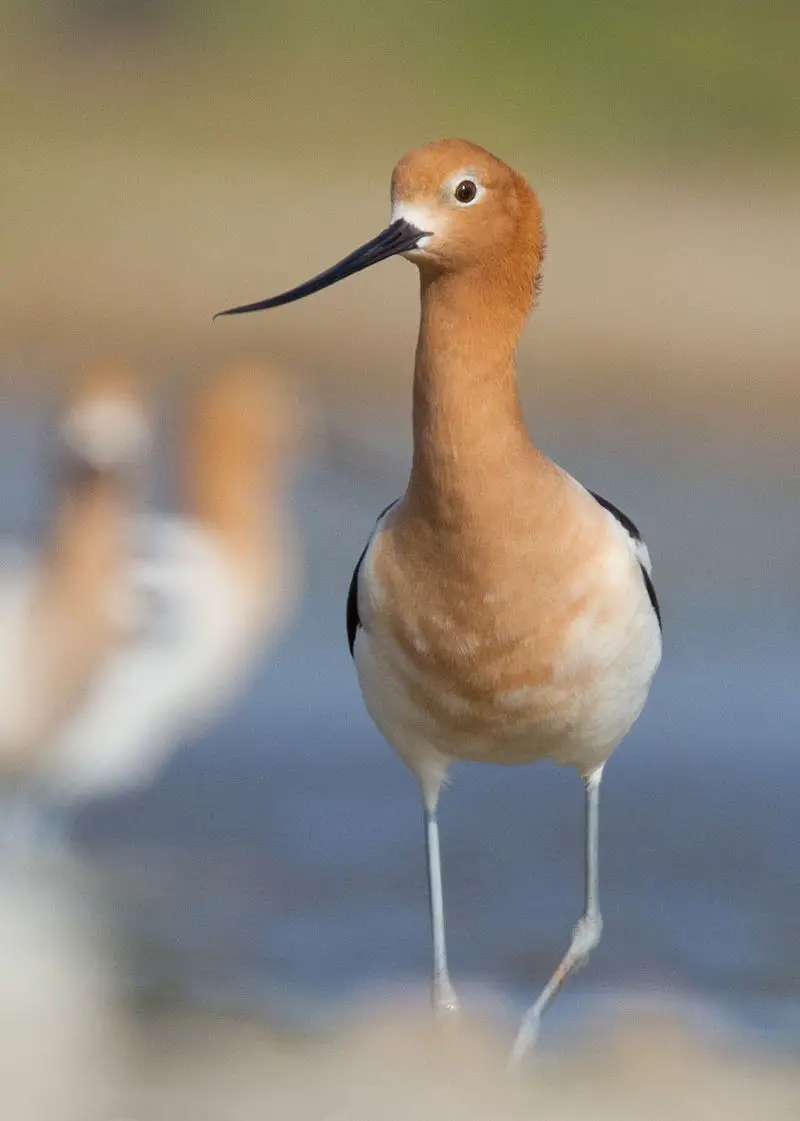
The American avocet is a stunningly beautiful bird found in North America. With its striking black and white plumage, long blue legs, and upturned bill it is an unmistakable sight.
It spends much of its time foraging around shallow water or mud flats searching for crustaceans and insects to feed on by sweeping its beak from side-to-side through the water.
The German naturalist Johann Friedr formally described this species back in 1789 as Recurvirostra americana – aptly named due to their habit of recurving their bills when feeding.
These graceful wading birds are truly a marvel of nature that deserve our admiration.Scientific classification:
| Kingdom | Animalia |
| Phylum | Chordata |
| Class | Aves |
| Order | Charadriiformes |
| Family | Recurvirostridae |
| Genus | Recurvirostra |
| Species | R. americana |
Also Featured In: Most Popular Bird Species in North America, Wetlands Birds You Should Know
2. Belted Kingfisher
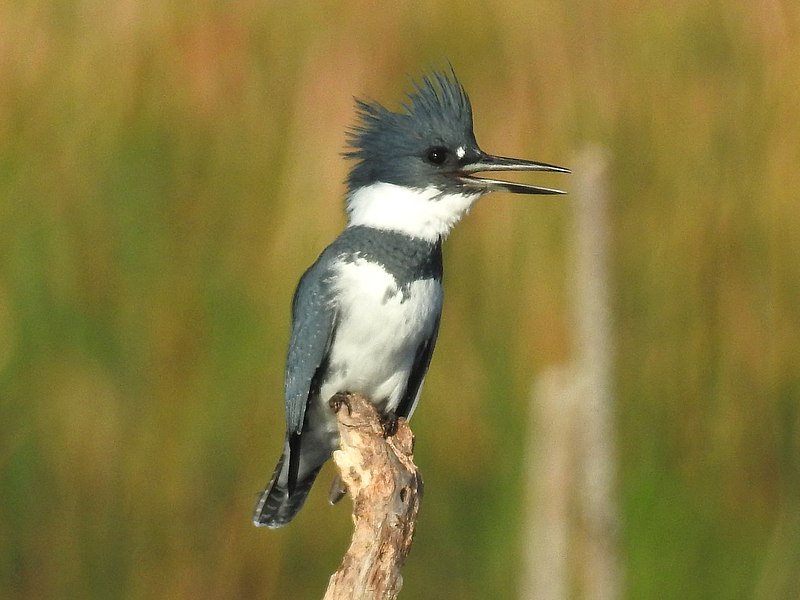
The belted kingfisher is a large, eye-catching bird native to North America. It belongs to the family Alcedinidae and has been divided into three subfamilies by recent research.
The species was first described in 1758 by Carl Linnaeus in his Systema Naturae.
This water Kingfisher stands out for its size as well as its striking plumage; males are bright blue on top with white below and females have rusty brown backs and wings with a thick black breast band across their chest.
They also possess an impressive call which can be heard from quite far away.
Belted kingfishers feed mainly on small fish but will sometimes also eat crustaceans, insects or even amphibians if they come across them while hunting around rivers or streams.
All in all, this is truly one remarkable bird that deserves our admiration.Scientific classification:
| Kingdom | Animalia |
| Phylum | Chordata |
| Class | Aves |
| Order | Coraciiformes |
| Family | Alcedinidae |
| Subfamily | Cerylinae |
| Genus | Megaceryle |
| Species | M. alcyon |
Also Featured In: Birds Live in Arkansas, New Hampshire Birds You Should Know
3. American White Pelican
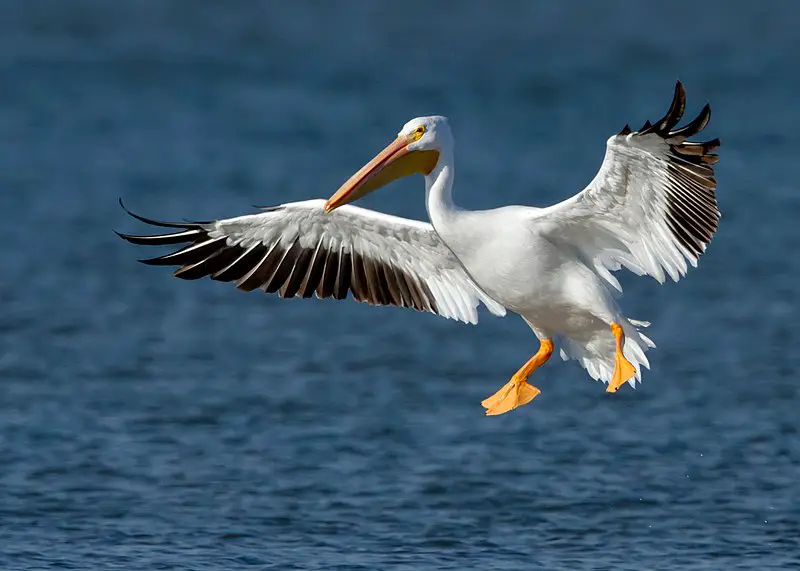
The American White Pelican is a majestic bird from the Pelecaniformes order, known for its impressive size and ability to soar gracefully in the sky.
It breeds during summer months in North America and migrates southwards towards Central and South America during winter.
The species was first described by German naturalist Johann Friedrich Gmelin back in 1789 as part of his updated version of Carl Linnaeus’ work.
This large aquatic bird has an all-white plumage with black primary flight feathers on its wings, while its beak features a characteristic yellowish colouration at the base near the face.
Its diet mainly consists of fish which it typically catches after dipping into water using its long bill; yet sometimes they can be seen stealing food items from other birds such as cormorants or gulls.Scientific classification:
| Kingdom | Animalia |
| Phylum | Chordata |
| Class | Aves |
| Order | Pelecaniformes |
| Family | Pelecanidae |
| Genus | Pelecanus |
| Species | P. erythrorhynchos |
Also Featured In: Birds You’ll Find in South Texas , Most Common Lake Birds
4. Common Grackle

The Common Grackle is a large icterid bird commonly found in North America. It has an iridescent head and pale yellow eyes, which are framed by its long dark bill and long tail.
Males typically have more vivid colors on their heads than females do. These birds can be seen across much of the continent, in fields, forests, wetlands – even urban areas.
They form huge flocks to search for food such as grains or insects that they catch with their bills.
The grackles may also scavenge from human sources like garbage dumps or picnic tables if available. With its colorful plumage and distinct call it’s easy to spot this species amongst other birds.Scientific classification:
| Kingdom | Animalia |
| Phylum | Chordata |
| Class | Aves |
| Order | Passeriformes |
| Family | Icteridae |
| Genus | Quiscalus |
| Species | Q. quiscula |
Also Featured In: Flocks Birds around Us, Birds Commonly Found in New York
5. Little Blue Heron
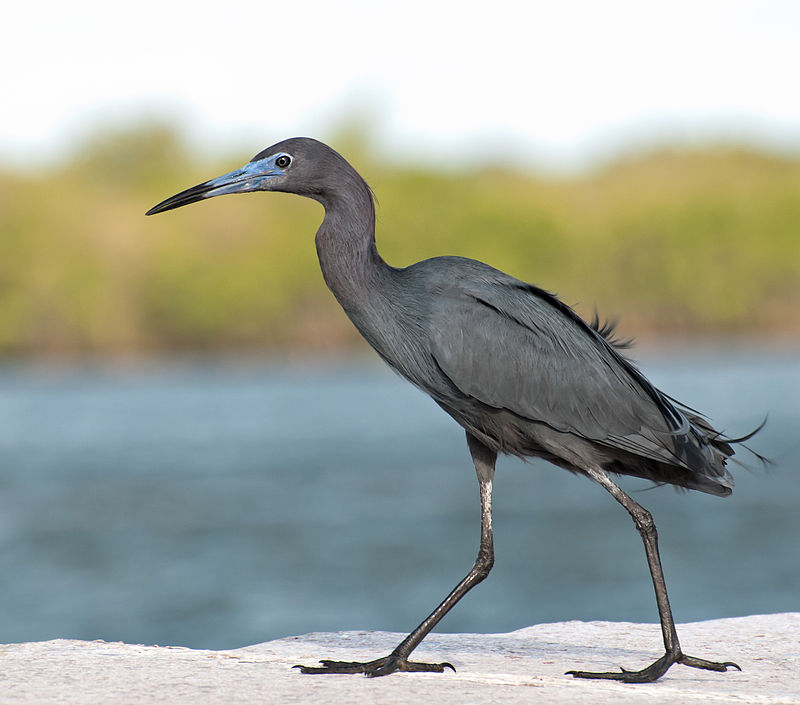
The Little Blue Heron is a small, darkly-colored heron with two-toned bill. Juveniles are completely white, similar to the Snowy Egret. In breeding season, adults develop unique coloration on their head and legs.
The bird has an expansive habitat range that covers much of the Americas from North America all the way down to South America.
They feed mostly in shallow water areas like tidal flats or marshes and eat small aquatic animals such as fish, frogs and crustaceans.
This species can also be found along coastal regions where they gather at night for roosting purposes during winter months when food sources become more scarce due to migration patterns of its prey animals.
These birds have adapted well over time allowing them to persist in most habitats throughout their wide range even despite environmental changes caused by human activities such as pollution or development projects near wetlands ecosystems which are essential for this species’ survival.Scientific classification:
| Kingdom | Animalia |
| Phylum | Chordata |
| Class | Aves |
| Order | Pelecaniformes |
| Family | Ardeidae |
| Genus | Egretta |
| Species | E. caerulea |
Also Featured In: Top Birds Found in Mexico, Swamps Birds You Should Know
6. Black Vulture
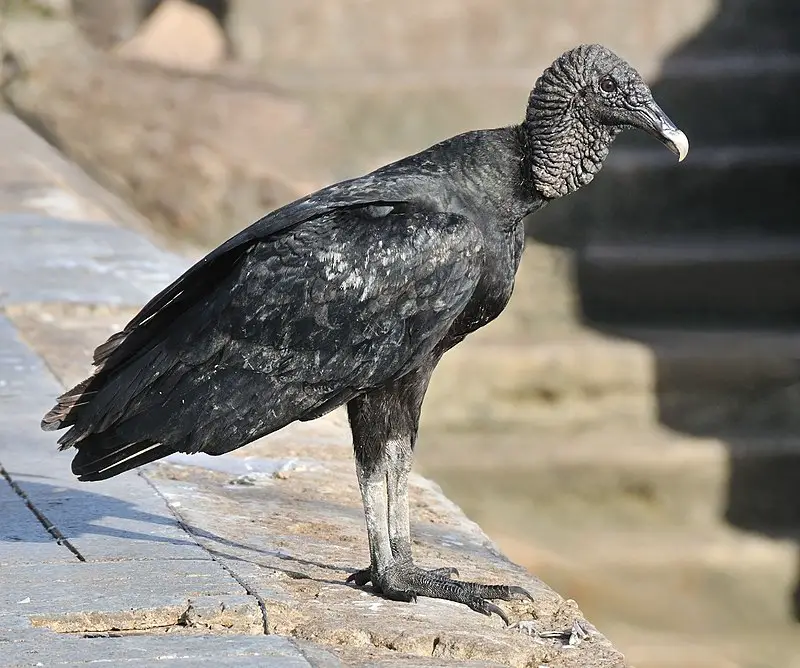
The black vulture is a common and widespread species of New World Vultures, found in the northeastern United States all the way to Peru, Central Chile and Uruguay.
It’s distinctive appearance has earned it many nicknames such as zopilote, urubu or gallinazo.
This medium-sized bird has mainly black plumage with some white markings on its wings and head; also featuring a long bill for scavenging carrion from carcasses.
Despite being able to fly up high due to its broad wingspan, it prefers keeping close to ground level when searching for food items like dead fish or small mammals that are available near human settlements.
As an apex predator they play an important role in nature by helping keep their environment clean while providing other animals with sustenance through their leftovers.Scientific classification:
| Kingdom | Animalia |
| Phylum | Chordata |
| Class | Aves |
| Order | Accipitriformes |
| Family | Cathartidae |
| Genus | Coragyps |
| Species | C. atratus |
Also Featured In: Most Common Birds Found in Chile, Birds You’ll Find in Zoo
7. Black-Bellied Whistling Duck
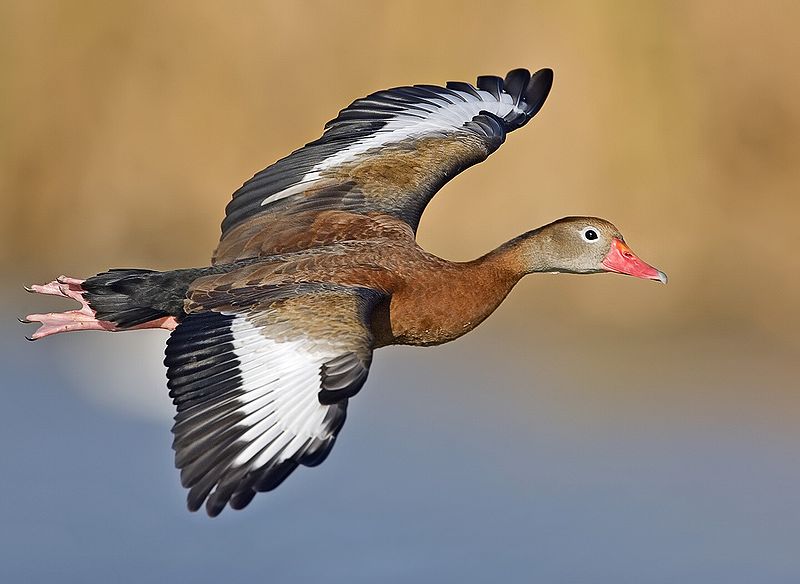
The Black-bellied whistling duck is a unique species of bird that can be found in the southern United States, Mexico, Central and South America. This small waterfowl has distinct black plumage on its belly which gives it its name.
Its call is also distinctive as it makes high pitched whistles to communicate with other members of its flock.
It prefers wetland habitats such as marshes, ponds and lakes where they feed on seeds and aquatic plants like wild rice or pondweed.
During breeding season these birds form monogamous pairs nesting in trees near bodies of water.
They are migratory birds but some may remain year round depending upon local climate conditions making them relatively common sights in certain areas during winter months when most other ducks have migrated further south for warmer weather.Scientific classification:
| Kingdom | Animalia |
| Phylum | Chordata |
| Class | Aves |
| Order | Anseriformes |
| Family | Anatidae |
| Genus | Dendrocygna |
| Species | D. autumnalis |
Also Featured In: El Salvador Birds, Common San Antonio Birds
8. Wood Stork
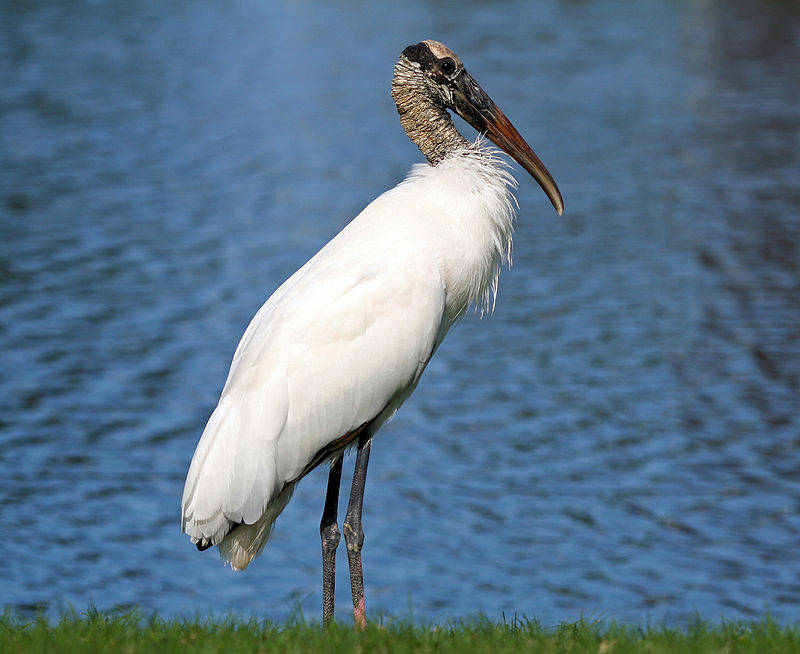
The Wood Stork is a large wading bird found in subtropical and tropical habitats throughout the Americas, including the Caribbean. It stands out from other storks due to its distinctive white head and neck feathers.
The wood stork has an impressive wingspan of up to 6 feet wide, making it one of the largest birds in North America.
Although usually seen near water sources such as swamps or wetlands looking for food like fish, crabs, frogs and even small reptiles they can sometimes be spotted far away from their natural habitat during migration season.
This species is also one of few that breeds annually in North America with nests typically built on platforms made by humans or animals near water bodies or ponds.Scientific classification:
| Kingdom | Animalia |
| Phylum | Chordata |
| Class | Aves |
| Order | Ciconiiformes |
| Family | Ciconiidae |
| Genus | Mycteria |
| Species | M. americana |
Also Featured In: Georgia Birds, Autumn Birds You Should Know
9. House Wren
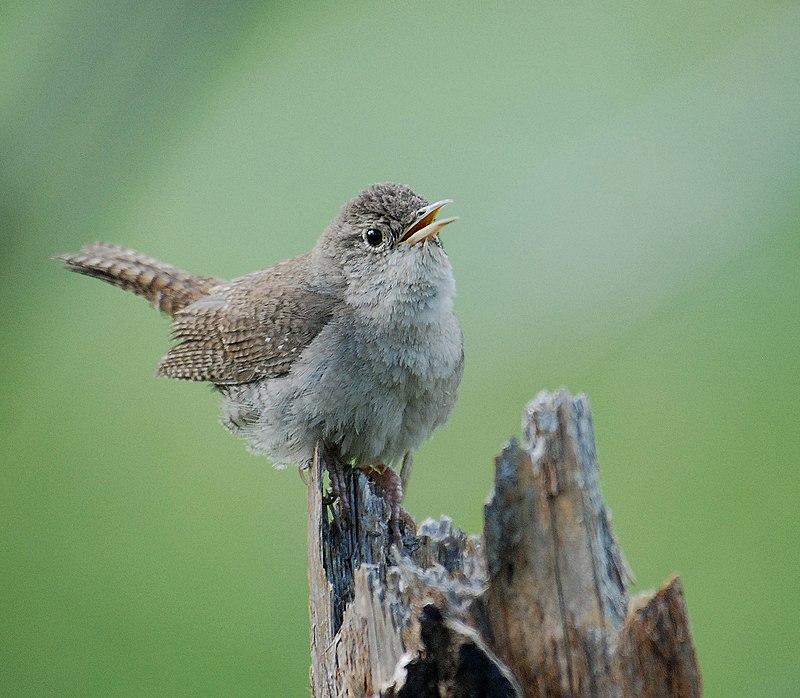
The House Wren is a small bird of the wren family found from Canada to South America. It’s quite common in suburban areas and is one of the most widely distributed native birds in North and South America.
Its taxonomy can be complicated, with some subspecies groups considered separate species.
The House Wren has a brown back, grey head, white eyebrow stripes, light chestnut belly and buffy flanks.
They often inhabit old or abandoned buildings as well as shrublands near fields or open woods for nesting sites.
During breeding season they are highly territorial so make sure you create an inviting environment if you wish to invite them into your yard.Scientific classification:
| Kingdom | Animalia |
| Phylum | Chordata |
| Class | Aves |
| Order | Passeriformes |
| Family | Troglodytidae |
| Genus | Troglodytes |
| Species | T. aedon |
Also Featured In: Suriname birds, House Birds You’ll Love to Pet
10. Common Gallinule
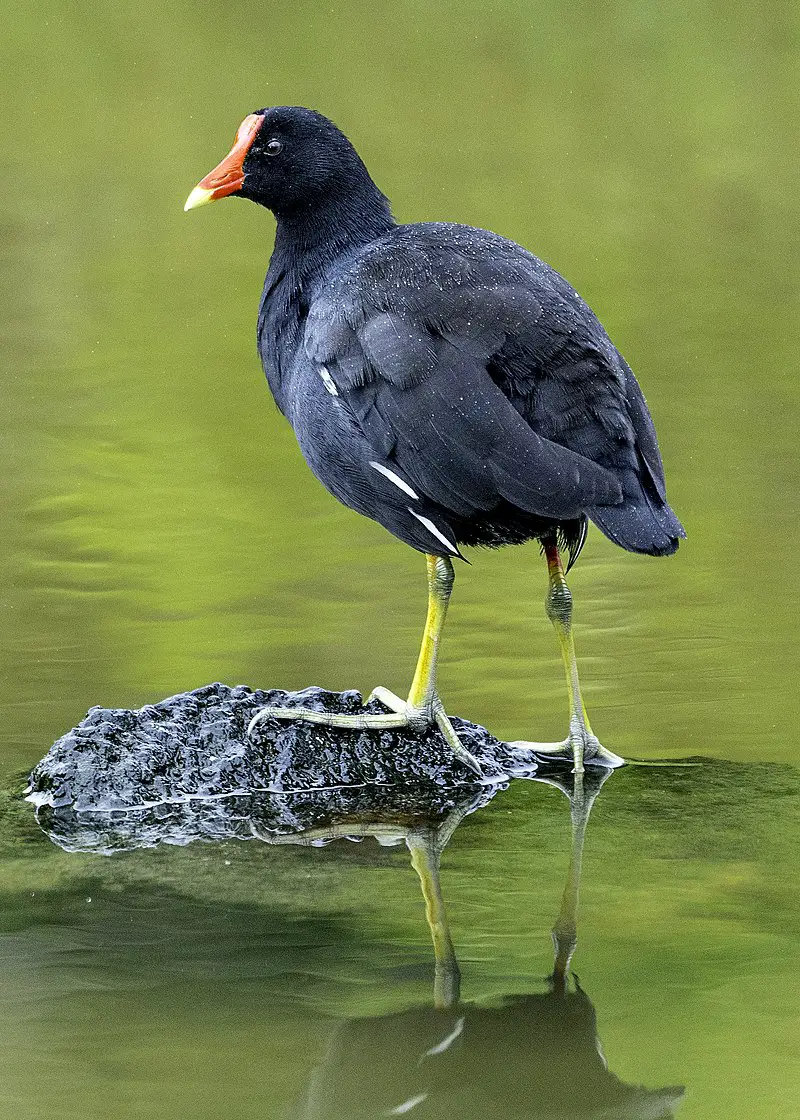
The Common Gallinule is a bird of the Rallidae family, native to parts of the Americas. It can be found in marshes, ponds and other wetland habitats which are well-vegetated.
This species prefers temperate climates and is not generally seen in polar regions or rainforests.
It has mainly greyish plumage with black wings and tail feathers, while its head has orange markings on either side along with an orange bill and yellow legs.
The underside usually appears white when flying but may have buffy undertones during breeding season.
Its diet consists primarily of aquatic vegetation as well as small invertebrates such as insects, snails or tadpoles; sometimes it will also take grains from fields nearby wetlands if available.
The Common Gallinule’s main call is a loud “kuk-kaa-kow” sound that can often be heard echoing across these areas where they reside.Scientific classification:
| Kingdom | Animalia |
| Phylum | Chordata |
| Class | Aves |
| Order | Gruiformes |
| Family | Rallidae |
| Genus | Gallinula |
| Species | G. galeata |
Also Featured In: Bermuda birds, Caribbean Birds
11. Blue-Gray Gnatcatcher
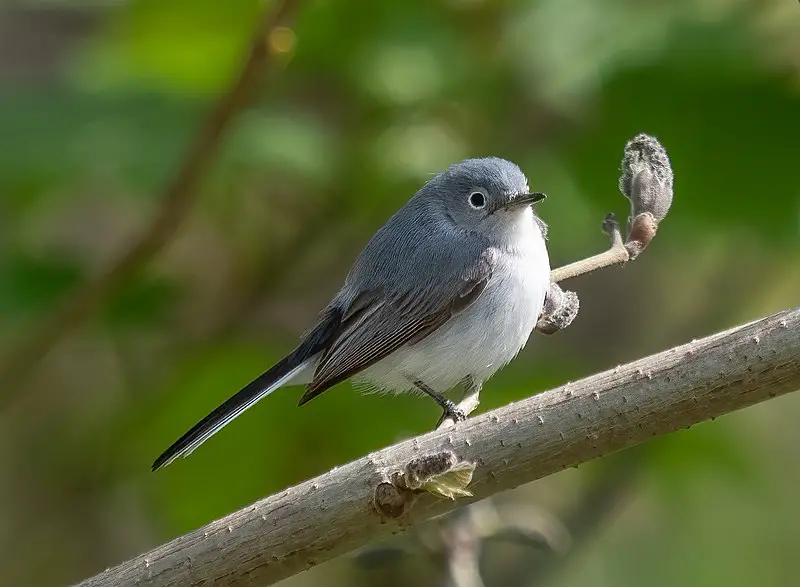
The Blue-gray Gnatcatcher is a beautiful small songbird native to North America. It has a length of 10–13 cm (3.9–5.1 in), wingspan of 6.3 in (16 cm) and weighs only 5–7 g (0.18–0.25 oz).
Males have blue-gray upperparts with white underparts, slender dark bill, and long black tail edged in white; females are less vibrant but still eye catching.
Juveniles are brownish gray overall but may show some hints of the adult colouration around their tails or shoulders as they mature into adulthood.
Their diet consists mainly of insects which they catch while flitting through air like tiny darts.
This stunning species can be found anywhere from woodlands to urban parks so keep your eyes peeled for these delightful creatures on your next outdoor adventure.Scientific classification:
| Kingdom | Animalia |
| Phylum | Chordata |
| Class | Aves |
| Order | Passeriformes |
| Family | Polioptilidae |
| Genus | Polioptila |
| Species | P. caerulea |
Also Featured In: Chickadees Birds, Birds That Live in Colorado
12. Black-And-White Warbler
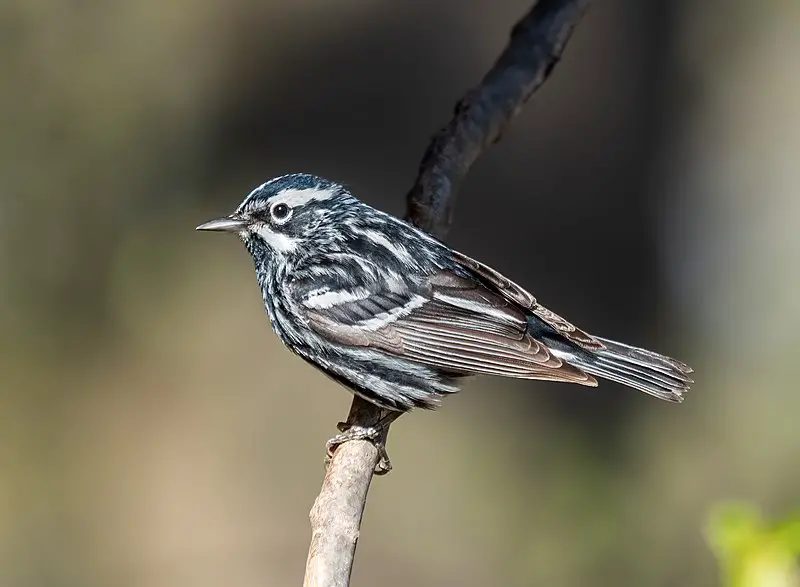
The Black-and-white Warbler is a unique species of bird native to North America. It has striking black and white plumage and breeds in the northern part of the continent, wintering in Central America, Florida, West Indies and Peru.
This warbler is rarely seen as far west as Europe but it’s still being studied for its behavior and ecology.
Its diet consists mainly of insects which it catches by clinging on trees like a woodpecker before quickly darting away again when prey appears.
The population size remains stable although they are vulnerable to habitat loss due to deforestation or other human activities so their conservation status should be monitored closely over time.Scientific classification:
| Kingdom | Animalia |
| Phylum | Chordata |
| Class | Aves |
| Order | Passeriformes |
| Family | Parulidae |
| Genus | Mniotilta Vieillot, 1816 |
| Species | M. varia |
Also Featured In: Nuthatches Species, Long Island Birds You Should Know
13. Double-Crested Cormorant

The double-crested cormorant is a majestic bird with an impressive wingspan, found across North America from the Aleutian Islands all the way down to Mexico.
Its black plumage stands out against its bright orange-yellow facial skin and some extended patches of white feathers on each side of its throat.
It measures between 28 – 35 inches in length and has webbed feet that enable it to swim gracefully through rivers and lakes, as well as coastal areas.
These birds are known for their voracious appetite for fish, sometimes diving over 100 ft deep into water looking for food.
Despite this reputation they also feed on crustaceans, amphibians and insects when available.
Cormorants have been part of many cultures throughout history due to their remarkable ability to fly long distances making them valued messengers or companions during fishing expeditions at sea.Scientific classification:
| Kingdom | Animalia |
| Phylum | Chordata |
| Class | Aves |
| Order | Suliformes |
| Family | Phalacrocoracidae |
| Genus | Nannopterum |
| Species | N. auritum |
Also Featured In: Cormorant Species, Water Birds Live around Us
14. Florida Scrub Jay
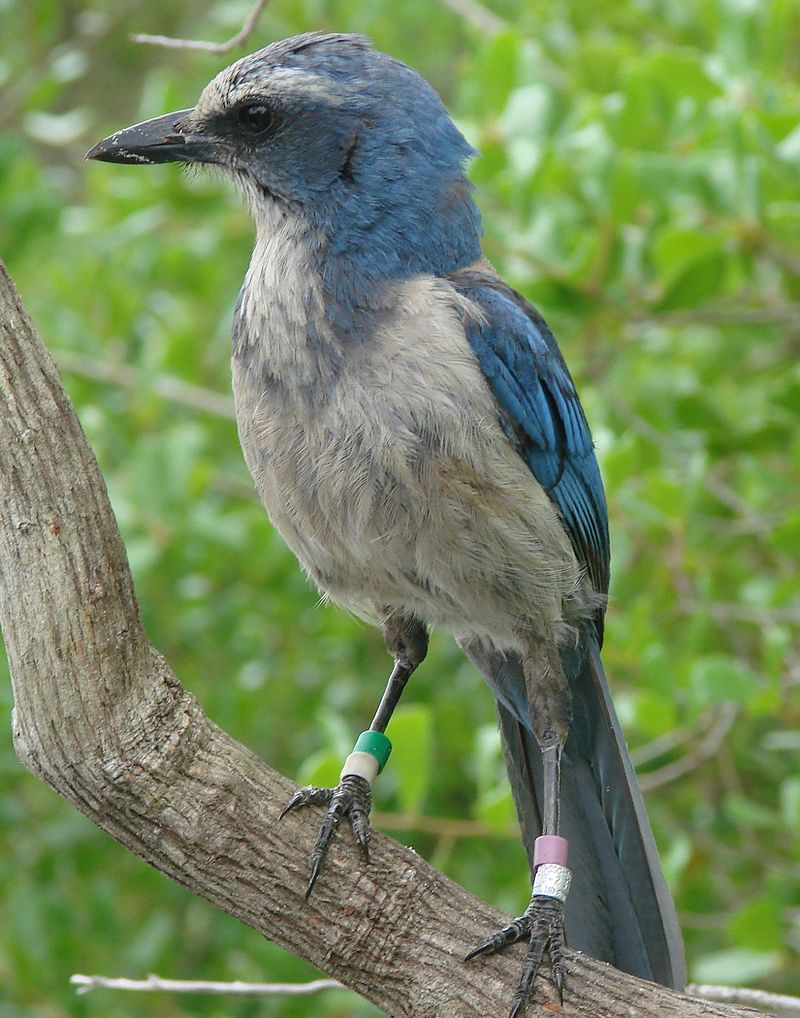
The Florida scrub jay is an important native bird species, endemic to the state of Florida and found nowhere else in the world. It has been around for at least two million years, making it a unique part of Floridian wildlife.
These birds are known for their distinctive blue-gray coloration with lighter underparts and white streaks across their wings.
They also have long legs and short tails that help them move quickly through open areas like sandy prairies or pinelands.
Scrub Jays feed mainly on insects but will take advantage of any food sources they find including fruit, nuts, eggs, small reptiles or amphibians if available.
Due to its restricted range this species is keenly sought by birders who want a chance to spot one in its natural habitat.Scientific classification:
| Kingdom | Animalia |
| Phylum | Chordata |
| Class | Aves |
| Order | Passeriformes |
| Family | Corvidae |
| Genus | Aphelocoma |
| Species | A. coerulescens |
Also Featured In: Florida Birds, Blue Birds You’ll Found around Us
15. Mottled Duck
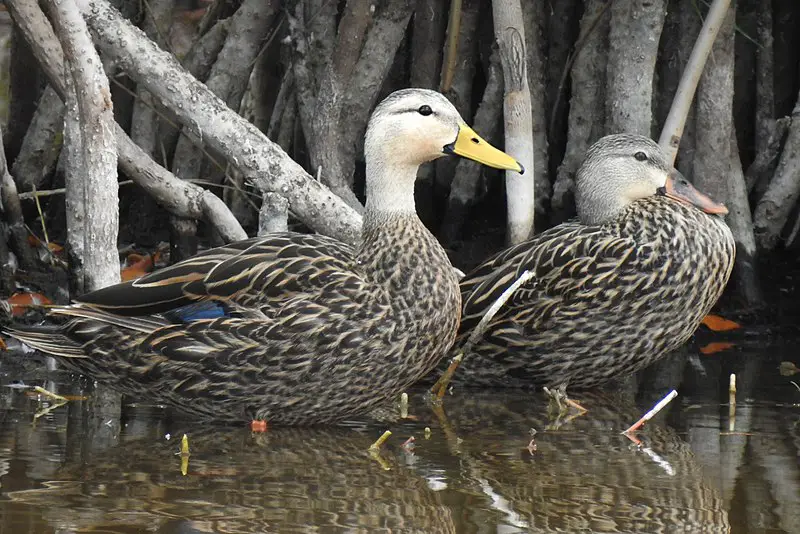
The mottled duck is a medium-sized dabbling duck, native to the Gulf of Mexico coast. It has an appearance that lies somewhere between that of a female mallard and an American black duck.
While it’s closely related to these two species, it shouldn’t be mistaken for either one – they are entirely distinct from each other.
They are also very commonly banded waterfowl in this region due to their abundance there.
This breed of ducks typically have tan or light brown feathers with white spots scattered around them, as well as bright orange bills and legs – making them quite attractive birds indeed.
All in all, the mottled duck makes for wonderful wildlife watching experience on any visit near its natural habitat.Scientific classification:
| Kingdom | Animalia |
| Phylum | Chordata |
| Class | Aves |
| Order | Anseriformes |
| Family | Anatidae |
| Genus | Anas |
| Species | A. fulvigula |
Also Featured In: Birds That Live around South Padre Island,
16. Boat-Tailed Grackle
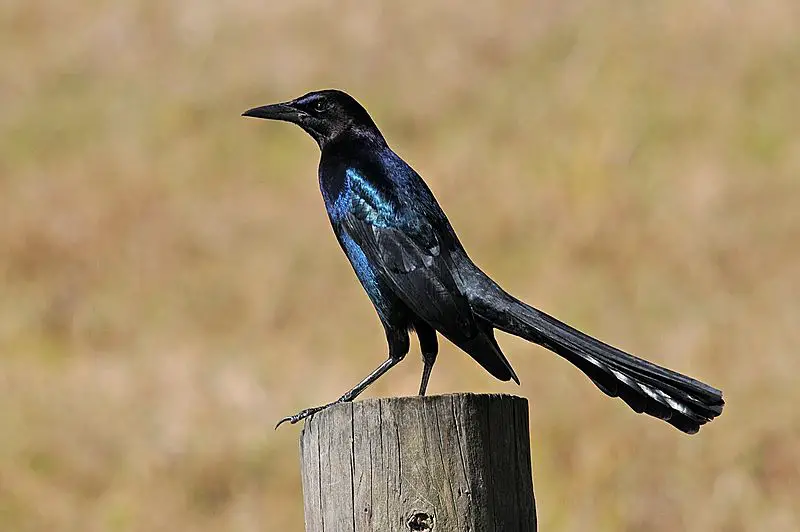
The Boat-tailed Grackle (Quiscalus major) is a passerine bird of the family Icteridae that lives permanently on the coasts of the Southeastern United States.
They inhabit coastal saltwater marshes and, in Florida, also inland waters.
These birds have been seen establishing large populations in various US Gulf Coast cities as well as towns where they can be found scavenging for food or nesting near human habitations.
The boat-tailed grackle has an iridescent black body with long tail feathers which give it its namesake appearance while their eyes are yellowish to brown and their legs pale blue/gray.
In addition to living in marshlands these birds feed mostly on insects but will also eat some fruits, seeds and other small prey like frogs or lizards.
Their loud vocalizations make them stand out from other species making them quite recognizable when heard.Scientific classification:
| Kingdom | Animalia |
| Phylum | Chordata |
| Class | Aves |
| Order | Passeriformes |
| Family | Icteridae |
| Genus | Quiscalus |
| Species | Q. major |
Also Featured In: Common Blue Birds of Georgia,
17. Anhinga
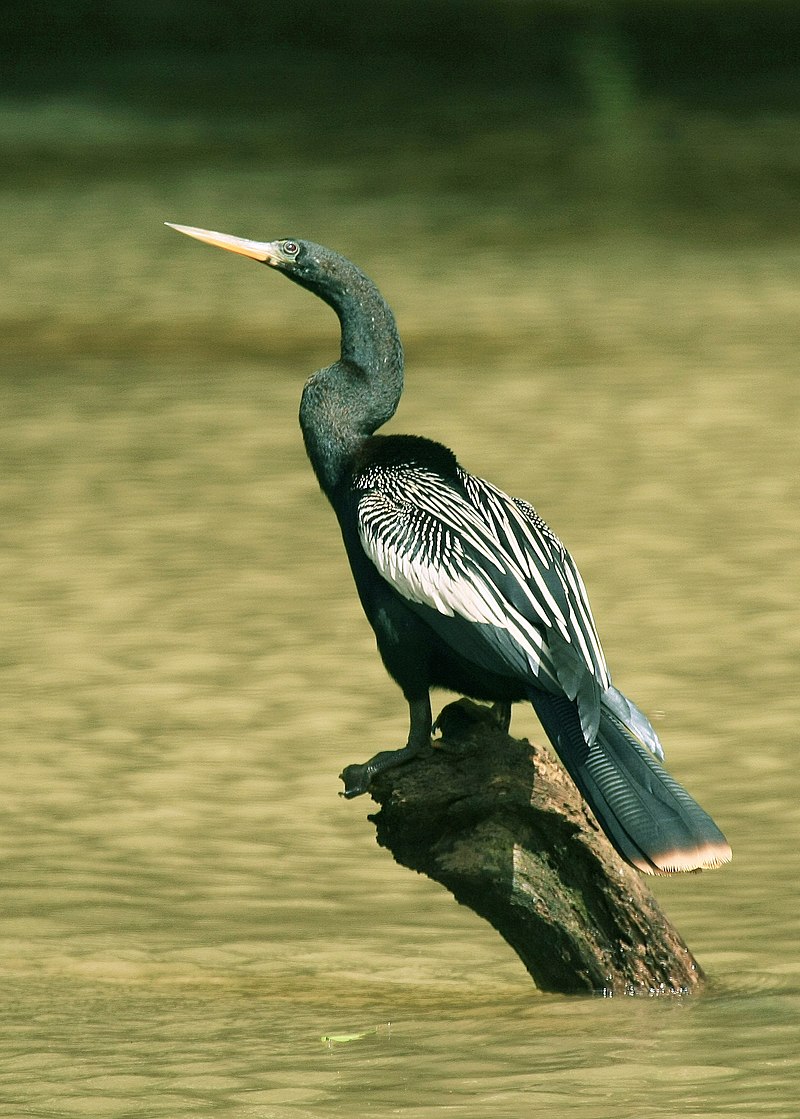
The Anhinga is a water bird found in the warmer parts of the Americas. It is sometimes called the snakebird, American darter, or water turkey.
The bird’s name comes from the Brazilian Tupi language and means “devil bird” or “snake bird.” When swimming, only the Anhinga’s neck appears above water, giving the appearance of a ready-to-strike snake.
It is a skilled swimmer and hunter, using its sharp beak to catch fish underwater. The Anhinga is easily recognizable by its long neck, sharp beak, and distinctive coloring of black and white feathers.
Its ability to dry its wings quickly after diving is unique among water birds, as it lacks the natural oils that make feathers waterproof.
The Anhinga is an important member of its ecosystem, helping to control fish populations and serving as prey for larger predators.Scientific classification:
| Kingdom | Animalia |
| Phylum | Chordata |
| Class | Aves |
| Order | Suliformes |
| Family | Anhingidae |
| Genus | Anhinga |
| Species | A. anhinga |
Also Featured In: Everglades Birds, Birds that Live around Southwest Florida